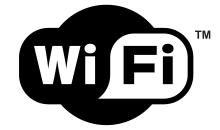Wi-fi
Wi-Fi ( English [ ˈwaɪ̯ˌfaɪ̯ ]) denotes both a company consortium that certifies devices with radio interfaces and the associated brand name .
Wi-Fi is an art term invented for marketing purposes that was formed by analogy with Hi-Fi . Whether it is an abbreviation like this is doubtful; the Wi certainly stands for " wireless ".
Wi-Fi is often used as a synonym for WLAN . Strictly speaking, WLAN and Wi-Fi are not the same: WLAN refers to the wireless network , while Wi-Fi refers to certification by the Wi-Fi Alliance based on the IEEE 802.11 standard - all Wi-Fi-certified products are therefore 802.11-compliant .

Wi-Fi Alliance
In 1999 the organization was originally founded under the name Wireless Ethernet Compatibility Alliance ( WECA ). 2002, WECA renamed in the Wi-Fi Alliance ® (following Wi-Fi Alliance called).
The task of the Wi ‑ Fi Alliance is to certify the products of different manufacturers on the basis of the IEEE 802.11 standard and thus to guarantee the operation with different radio devices ( interoperability ). The background to this was that the standard was not fully implemented in many products or was weakened by proprietary extensions. This often resulted in incompatibilities between products from different manufacturers.
The Wi-Fi Alliance tests the relevant components according to its own guidelines. Products that pass the test receive the Wi-Fi certificate and are therefore allowed to carry the “Wi-Fi” logo . However, only the products of the Wi-Fi members are tested. Members must pay a fee in addition to the membership fee for each component tested. A missing Wi-Fi logo does not necessarily represent a deviation from the standard.
The consortium announced on 31 October 2002 announced with Wi-Fi Protected Access (WPA) is a subset of the then future IEEE standards 802.11i to establish itself as a new encryption technique before the adoption of the new standards the applicable as unsafe encryption methods WEP replace . After the adoption of 802.11i, Wi-Fi coined the term WPA2 .
The Wi ‑ Fi alliance has over 300 companies as members. Here is a selection of the members:
Naming
The name Wi ‑ Fi, which was already in commercial use in August 1999, was coined by the brand consultancy Interbrand . The Wi ‑ Fi Alliance commissioned Interbrand to create a name that is “a little more catchy than IEEE 802.11b Direct Sequence ”. Phil Belanger, a founding member of the Wi-Fi Alliance who presided over the name Wi-Fi , said that Interbrand invented Wi-Fi as a pun on the word Hi-Fi .
Interbrand also designed the Wi-Fi logo. The ying-yang- like Wi-Fi logo indicates that a product has been certified for compatibility.
The Wi ‑ Fi Alliance used the slogan “ The Standard for Wireless Fidelity ” shortly after the brand was founded. However, the name was never officially " Wireless Fidelity " (in German "cordless playback fidelity"). Nevertheless, the Wi ‑ Fi alliance was also referred to as the Wireless Fidelity Alliance Inc. in some publications and the IEEE website reads “ WiFi is a short name for Wireless Fidelity ” (in German “WiFi is an abbreviation for wireless playback fidelity”) .
Non-Wi-Fi technologies that are used for control points such as B. Motorola Canopy , are commonly referred to as wireless landlines. Alternative cellular technologies include cellular standards such as 2G, 3G, 4G and LTE.
The name is sometimes spelled WiFi , Wifi or wifi , but these spellings are not recognized by the Wi ‑ Fi Alliance.
In October 2018, the Wi ‑ Fi Alliance announced that radio network technologies would in future be called Wi ‑ Fi 4 , Wi ‑ Fi 5 and Wi ‑ Fi 6 in order to make it easier for users to differentiate between generations.
The number of parallel MIMO streams is directly included in the transmission rate, but cannot be seen from the designation, so it is specified as the from-to range.
| designation | IEEE standard | Maximum link rate |
|---|---|---|
| Wi-Fi 6 | 802.11ax | 600-9608 Mbit / s |
| Wi ‑ Fi 5 | 802.11ac | 433-6933 Mbps |
| Wi-Fi 4 | 802.11n | 72-600 Mbit / s |
| 802.11g | 54 Mbit / s | |
| 802.11b | 11 Mbit / s | |
| 802.11 | 2 Mbit / s |
On the application side, about half the link rate can be achieved.
Web links
- Wi-Fi Alliance website. In: wi-fi.org (English)
- Wi-Fi tutorial. In: tutorial-reports.com (English)
- Wi-Fi FAQ. In: infos247.com (English)
Individual evidence
- ↑ WiFi isn't short for "Wireless Fidelity". In: boingboing.net. November 8, 2005, accessed June 10, 2016 .
- ↑ Wireless Ethernet Compatibility Alliance (WECA) Awards New Wi-Fi Interoperability Certification. In: wi-fi.org , May 8, 2000, accessed December 26, 2014
- ↑ Eric Griffith: WECA becomes Wi-Fi Alliance . In: Internet News . October 2, 2002. Retrieved November 7, 2013.
- ^ Wi-Fi Alliance: Member Companies
- ↑ a b WiFi isn't short for “Wireless Fidelity” / Boing Boing. Retrieved June 25, 2018 (American English).
- ↑ "wireless fidelity" Debunked. September 28, 2007. Retrieved June 25, 2018 .
- ↑ WiFi isn't short for “Wireless Fidelity” / Boing Boing. June 20, 2017. Retrieved June 25, 2018 .
- ^ A b Securing Wi-Fi Wireless Networks with Today's Technologies. (PDF) In: Net Sense: IT Consulting Services. Wi-Fi Alliance, February 6, 2003, accessed May 25, 2018 .
- ^ David Pogue: What Wi-Fi Stands for — and Other Wireless Questions Answered . In: Scientific American . ( scientificamerican.com [accessed June 25, 2018]).
- ↑ Editor Computerhilfe.de: New WIFI names: IEEE-802.11ac is now Wi-Fi 5 - Computerhilfe.de . In: Computerhilfe.de . October 6, 2018 ( computerhilfe.de [accessed October 6, 2018]).
- ↑ Wi-Fi 6th Wi-Fi Alliance, accessed November 25, 2018 .
- ↑ a b c Ernst Ahlers: WLAN generations. In: c't. Heise online , January 5, 2019, accessed on January 7, 2019 .
